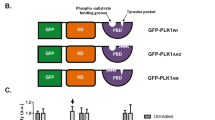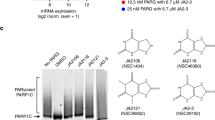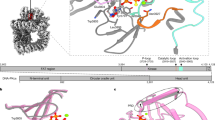Abstract
We obtained unanticipated synthetic byproducts from alkylation of the δ1 nitrogen (N3) of the histidine imidazole ring of the polo-like kinase-1 (Plk1) polo-box domain (PBD)-binding peptide PLHSpT. For the highest-affinity byproduct, bearing a C6H5(CH2)8– group, a Plk1 PBD cocrystal structure revealed a new binding channel that had previously been occluded. An N-terminal PEGylated version of this peptide containing a hydrolytically stable phosphothreonyl residue (pT) bound the Plk1 PBD with affinity equal to that of the non-PEGylated parent but showed markedly less interaction with the PBDs of the two closely related proteins Plk2 and Plk3. Treatment of cultured cells with this PEGylated peptide resulted in delocalization of Plk1 from centrosomes and kinetochores and in chromosome misalignment that effectively induced mitotic block and apoptotic cell death. This work provides insights that might advance efforts to develop Plk1 PBD-binding inhibitors as potential Plk1-specific anticancer agents.
This is a preview of subscription content, access via your institution
Access options
Subscribe to this journal
Receive 12 print issues and online access
$259.00 per year
only $21.58 per issue
Buy this article
- Purchase on Springer Link
- Instant access to full article PDF
Prices may be subject to local taxes which are calculated during checkout


Similar content being viewed by others
References
Barr, F.A., Sillje, H.H.W. & Nigg, E.A. Polo-like kinases and the orchestration of cell division. Nat. Rev. Mol. Cell Biol. 5, 429–440 (2004).
Dai, W. Polo-like kinases, an introduction. Oncogene 24, 214–216 (2005).
Lowery, D.M., Lim, D. & Yaffe, M.B. Structure and function of polo-like kinases. Oncogene 24, 248–259 (2005).
van de Weerdt, B.C.M. & Medema, R.H. Polo-like kinases: a team in control of the division. Cell Cycle 5, 853–864 (2006).
Archambault, V. & Glover, D.M. Polo-like kinases: conservation and divergence in their functions and regulation. Nat. Rev. Mol. Cell Biol. 10, 265–275 (2009).
Strebhardt, K. & Ullrich, A. Targeting polo-like kinase 1 for cancer therapy. Nat. Rev. Cancer 6, 321–330 (2006).
Eckerdt, F., Yuan, J. & Strebhardt, K. Polo-like kinases and oncogenesis. Oncogene 24, 267–276 (2005).
Takai, N., Hamanaka, R., Yoshimatsu, J. & Miyakawa, I. Polo-like kinases (Plks) and cancer. Oncogene 24, 287–291 (2005).
Goh, K.C. et al. PLK1 as a potential drug target in cancer therapy. Drug Dev. Res. 62, 349–361 (2004).
McInnes, C., Mezna, M. & Fischer, P.M. Progress in the discovery of polo-like kinase inhibitors. Curr. Top. Med. Chem. 5, 181–197 (2005).
Gumireddy, K. et al. ON01910, a non–ATP-competitive small molecule inhibitor of Plk1, is a potent anticancer agent. Cancer Cell 7, 275–286 (2005).
Lansing, T.J. et al. In vitro biological activity of a novel small-molecule inhibitor of polo-like kinase 1. Mol. Cancer Ther. 6, 450–459 (2007).
Lénárt, P. et al. The small-molecule inhibitor BI 2536 reveals novel insights into mitotic roles of polo-like kinase 1. Curr. Biol. 17, 304–315 (2007).
Lu, L.-Y. & Yu, X. The balance of Polo-like kinase 1 in tumorigenesis. Cell Div. 4, 4 (2009).
Reindl, W., Yuan, J., Kraemer, A., Strebhardt, K. & Berg, T.A. Pan-specific inhibitor of the polo-box domains of polo-like kinases arrests cancer cells in mitosis. ChemBioChem 10, 1145–1148 (2009).
Strebhardt, K. Multifaceted polo-like kinases: drug targets and antitargets for cancer therapy. Nat. Rev. Drug Discov. 9, 643–660 (2010).
Burns, T.F., Fei, P., Scata, K.A., Dicker, D.T. & El-Deiry, W.S. Silencing of the novel p53 target gene Snk/Plk2 leads to mitotic catastrophe in paclitaxel (taxol)-exposed cells. Mol. Cell. Biol. 23, 5556–5571 (2003).
Xie, S., Xie, B., Lee, M.Y. & Dai, W. Regulation of cell cycle checkpoints by polo-like kinases. Oncogene 24, 277–286 (2005).
Elia, A.E.H., Cantley, L.C. & Yaffe, M.B. Proteomic screen finds pSer/pThr-binding domain localizing Plk1 to mitotic substrates. Science 299, 1228–1231 (2003).
Elia, A.E.H. et al. The molecular basis for phosphodependent substrate targeting and regulation of Plks by the polo-box domain. Cell 115, 83–95 (2003).
Cheng, K.-Y., Lowe, E.D., Sinclair, J., Nigg, E.A. & Johnson, L.N. The crystal structure of the human polo-like kinase-1 polo box domain and its phospho-peptide complex. EMBO J. 22, 5757–5768 (2003).
Reindl, W., Yuan, J., Kraemer, A., Strebhardt, K. & Berg, T. Inhibition of Polo-like kinase 1 by blocking Polo-box domain-dependent protein-protein interactions. Chem. Biol. 15, 459–466 (2008).
Yun, S.-M. et al. Structural and functional analyses of minimal phosphopeptides targeting the polo-box domain of polo-like kinase 1. Nat. Struct. Mol. Biol. 16, 876–882 (2009).
Watanabe, N. et al. Deficiency in chromosome congression by the inhibition of Plk1 Polo box domain-dependent recognition. J. Biol. Chem. 284, 2344–2353 (2009).
Jang, Y.-J., Lin, C.-Y., Ma, S. & Erikson, R.L. Functional studies on the role of the C-terminal domain of mammalian polo-like kinase. Proc. Natl. Acad. Sci. USA 99, 1984–1989 (2002).
Lee, K.S., Grenfell, T.Z., Yarm, F.R. & Erikson, R.L. Mutation of the polo-box disrupts localization and mitotic functions of the mammalian polo kinase Plk. Proc. Natl. Acad. Sci. USA 95, 9301–9306 (1998).
Seong, Y.-S. et al. A spindle checkpoint arrest and a cytokinesis failure by the dominant-negative polo-box domain of Plk1 in U-2 OS cells. J. Biol. Chem. 277, 32282–32293 (2002).
Wipf, P. et al. A case study from the chemistry core of the Pittsburgh molecular library screening center: the polo-like kinase polo-box domain (Plk1-PBD). Curr. Top. Med. Chem. 9, 1194–1205 (2009).
Li, L. et al. The natural product Aristolactam AIIIa as a new ligand targeting the polo-box domain of polo-like kinase 1 potently inhibits cancer cell proliferation. Acta Pharmacol. Sin. 30, 1443–1453 (2009).
García-Alvarez, B., de, C.G., Ibanez, S., Bragado-Nilsson, E. & Montoya, G. Molecular and structural basis of polo-like kinase 1 substrate recognition: implications in centrosomal localization. Proc. Natl. Acad. Sci. USA 104, 3107–3112 (2007).
Huggins, D.J. et al. Computational analysis of phosphopeptide binding to the polo-box domain of the mitotic kinase PLK1 using molecular dynamics simulation. PLOS Comput. Biol. 6, e1000880 (2010).
Liu, F., Park, J.-E., Lee, K.S. & Burke, T.R. Jr. Preparation of orthogonally protected (2S,3R)-2-amino-3-methyl-4-phosphonobutyric acid (Pmab) as a phosphatase-stable phosphothreonine mimetic and its use in the synthesis of polo-box domain-binding peptides. Tetrahedron 65, 9673–9679 (2009).
Swamy, K.C.K., Kumar, N.N.B., Balaraman, E. & Kumar, K.V.P.P. Mitsunobu and related reactions: advances and applications. Chem. Rev. 109, 2551–2651 (2009).
McGovern, S.L. Promiscuous ligands. Compr. Med. Chem. II 2, 737–752 (2006).
Coan, K.E.D., Maltby, D.A., Burlingame, A.L. & Shoichet, B.K. Promiscuous aggregate-based inhibitors promote enzyme unfolding. J. Med. Chem. 52, 2067–2075 (2009).
Bhadra, D., Bhadra, S., Jain, P. & Jain, N.K. Pegnology: a review of PEG-ylated systems. Pharmazie 57, 5–29 (2002).
Roberts, M.J., Bentley, M.D. & Harris, J.M. Chemistry for peptide and protein PEGylation. Adv. Drug Deliv. Rev. 54, 459–476 (2002).
Pisal, D.S., Kosloski, M.P. & Balu-Iyer, S.V. Delivery of therapeutic proteins. J. Pharm. Sci. 99, 2557–2575 (2010).
Tsuchida, E. et al. Artificial oxygen carriers, hemoglobin vesicles and albumin-hemes, based on bioconjugate chemistry. Bioconjug. Chem. 20, 1419–1440 (2009).
Miller, M.A. et al. Amphiphilic conjugates of human brain natriuretic peptide designed for oral delivery: in vitro activity screening. Bioconjug. Chem. 17, 267–274 (2006).
Khedkar, A. et al. A dose range finding study of novel oral insulin (IN-105) under fed conditions in type 2 diabetes mellitus subjects. Diabetes Obes. Metab. 12, 659–664 (2010).
Bellouard, F., Chuburu, F., Yaouanc, J.-J., Handel, H. & Le Mest, Y. A convenient synthetic route to polyether-tagged cyclam ligands and their nickel derivatives. Eur. J. Org. Chem. 1999, 3257–3261 (1999).
Kanda, Y., Ashizawa, T., Kawashima, K., Ikeda, S.-i. & Tamaoki, T. Synthesis and antitumor activity of novel C-8 ester derivatives of leinamycin. Bioorg. Med. Chem. Lett. 13, 455–458 (2003).
Ahonen, L.J. et al. Polo-like kinase 1 creates the tension-sensing 3F3/2 phosphoepitope and modulates the association of spindle-checkpoint proteins at kinetochores. Curr. Biol. 15, 1078–1089 (2005).
Śledź, P. et al. From crystal packing to molecular recognition: Prediction and discovery of a binding site on the surface of polo-like kinase 1. Agnew Chem. Int. Ed. Engl. 50, 4003–4006 (2011).
Liu, X. & Erikson, R.L. Polo-like kinase 1 in the life and death of cancer cells. Cell Cycle 2, 424–425 (2003).
Luo, J. et al. A Genome-wide RNAi screen identifies multiple synthetic lethal interactions with the ras oncogene. Cell 137, 835–848 (2009).
Sur, S. et al. A panel of isogenic human cancer cells suggests a therapeutic approach for cancers with inactivated p53. Proc. Natl. Acad. Sci. USA 106, 3964–3969 (2009).
Kang, Y.H. et al. Self-regulated Plk1 recruitment to kinetochores by the Plk1-PBIP1 interaction is critical for proper chromosome regulation. Mol. Cell. 24, 409–422 (2006).
Acknowledgements
This work was supported in part by grants ZIA BC 006198 (T.R.B.) and ZIA BC 010681 (K.S.L.) of the Intramural Research Program of the US National Institutes of Health, Center for Cancer Research, National Cancer Institute–Frederick and the US National Cancer Institute, US National Institutes of Health (F.L., J.-E.P., W.-J.Q., K.S.L. and T.R.B.), US National Institutes of Health grants GM60594, GM68762 and CA112967 (M.B.Y.) and the Deutsche Forschungsgemeinschaft (grant BE 4572/1-1) (T.B.). We thank M. Dyba of the Biophysics Resource of the Structural Biophysics Laboratory, National Cancer Institute Frederick for assistance in performing tandem MS studies and W. Dai, New York University School of Medicine for the Flag-Plk3 construct. The content of this publication does not necessarily reflect the views or policies of the Department of Health and Human Services, nor does mention of trade names, commercial product or organizations imply endorsement by the US government.
Author information
Authors and Affiliations
Contributions
F.L., J.-E.P., W.-J.Q., D.L., M.G., T.B., M.B.Y., K.S.L. and T.R.B. designed the experiments; F.L., J.-E.P., W.-J.Q., D.L. and M.G. conducted the experiments and F.L., J.-E.P., W.-J.Q., D.L., M.G., T.B., M.B.Y., K.S.L. and T.R.B. analyzed the data and wrote the paper.
Corresponding authors
Ethics declarations
Competing interests
The authors declare no competing financial interests.
Supplementary information
Supplementary Text and Figures
Supplementary Methods and Supplementary Results (PDF 17027 kb)
Rights and permissions
About this article
Cite this article
Liu, F., Park, JE., Qian, WJ. et al. Serendipitous alkylation of a Plk1 ligand uncovers a new binding channel. Nat Chem Biol 7, 595–601 (2011). https://doi.org/10.1038/nchembio.614
Received:
Accepted:
Published:
Issue Date:
DOI: https://doi.org/10.1038/nchembio.614
This article is cited by
-
A TAT-conjugated peptide inhibitor of polo-like kinase 1 for in vivo tumor imaging
Journal of Analytical Science and Technology (2019)
-
A cryptic hydrophobic pocket in the polo-box domain of the polo-like kinase PLK1 regulates substrate recognition and mitotic chromosome segregation
Scientific Reports (2019)
-
Identification of Polo-like kinase 1 interaction inhibitors using a novel cell-based assay
Scientific Reports (2016)
-
Putting a bit into the polo-box domain of polo-like kinase 1
Journal of Analytical Science and Technology (2015)
-
Understanding the Polo Kinase machine
Oncogene (2015)



